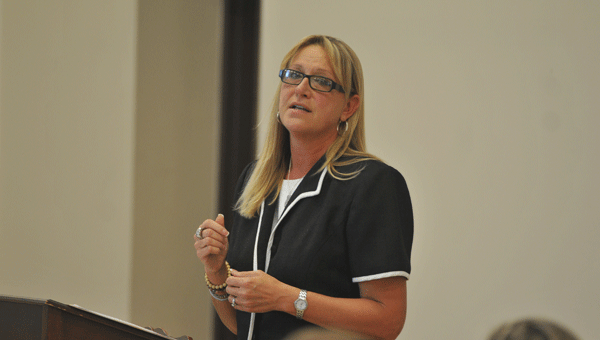BOE addresses student achievement
Published 6:50 pm Friday, August 18, 2017

- Lisa Adair, curriculum and instructional leader, discussed ways in which the Butler County BOE could address the county’s student achievement deficit during Thursday’s board meeting.
Lisa Adair, the Butler County School System’s newly hired curriculum and instructional leader, presented some “brutal” facts to the board and participating community members during Thursday monthly meeting.
The bottom line, according to data taken from the 2016-17 school year’s test results, is that Butler County’s students are underperforming across several core subject areas.
ACT Aspire, which prepares students in grades 3-8 and 10th grade for the proper ACT in 11th grade, revealed less than flattering statistics for student benchmarks.
Twenty-seven percent of Butler County students benchmarked in math. Twenty-three percent benchmarked in reading, 58 percent tested as proficient in English (testing grammar and editing specifically) and 22 percent proved proficient in science.
Data was also collected from 11th graders taking the ACT. Butler County’s students fall behind statewide averages in all categories.
Twenty-eight percent of Butler County students benchmarked in English, compared to 46 percent statewide.
Nine percent benchmarked in math, trailing the statewide average of 20 percent.
Seventeen percent benchmarked in reading, behind a 30-percen statewide average.
Eight percent benchmarked in science, 14 percentage points behind the statewide average of 22 percent.
And only six percent of Butler County students benchmarked in all four subject areas, compared to 13 percent statewide.
The average Butler County composite ACT score was 16.1, trailing the statewide average of 18.4.
Adair said that among her immediate plans is to begin building teams to help increase the county’s numbers.
“Teachers’ lesson plans don’t tell us a lot about what kids are learning, but student work does,” Adair said.
“And so we need to build that capacity for teachers to look at an analyze student work to figure out how they can get more meaningful feedback in order to help grow students.”
Adair added that leveling the playing field should be among the system’s top priorities, and addressing the gap between students’ grades and their proficiency in statewide testing.
“We have to teach every child to read, at the very least,” she said.
“You’ve seen what’s on the report cards. You see a lot of A’s and B’s on report cards, but we’re not benchmarking on our assessments. So there’s a gap between the data and the grades. We’ve got to figure out why.”
Part of the source of the county’s problems, she said, could lie in intervention methods for young students struggling with reading. To that end, Adair spent most of her very first week on the job with reading specialists who focus on K-3 to get intervention models in place to help young struggling readers.
“We cannot keep moving kids on who cannot read,” she said. “Some kids just take longer. It does not mean they have a disability. It does not mean that they cannot read. Retention is not a failure. It is another chance to offer that child academic success.
“If you are not reading on grade level by the end of fourth grade, there is a 75 percent chance you will never read on grade level.”
Board members Brandon Sellers and Linda Hamilton weighed in on the data, urging parents in attendance to take the studies to heart.
“Since we have a large crowd here, we need your support,” Sellers said. “Go out into the community. Tell the parents, grandparents, aunts and uncles and even older siblings—just because a child says they’ve done their homework at night doesn’t mean they understand what they’ve done. It doesn’t mean that the homework was done correctly. Sit down and go over it with them. I’m not saying we should all be able to sit down and do 11th-grade trig, but looking at these numbers for third, fourth and fifth graders, we can all try.
“If we can get others to do the same, we can make these numbers go up. It’s not going to happen overnight, but it will go up.”
“Let our kids see us reading, or that we have books that we value reading,” Hamilton added. “Read with them. Oftentimes, the library is giving away books.
“All of our kids must learn to read, and we can help them—all of us—if we get involved. Kids need to read something every day when they come home.”





